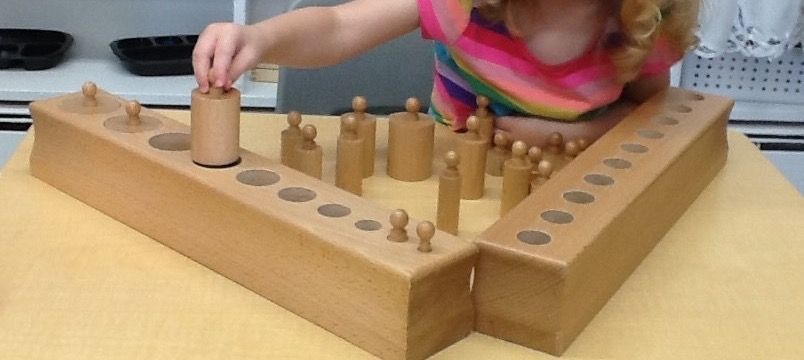
You'd be hard pressed to visit any Montessori early childhood classroom in the world and not find the Knobbed Cylinders on the shelf. From the first block that finds its way into the Toddler classrooms to the full complement of four cylinder blocks that the Early Childhood classrooms enjoy, the Knobbed Cylinders are a foundational material that naturally attracts the young child to work.
Designed to isolate the relationship between dimension and volume, each cylinder block offers the child ten different cylinders, differing in their relative heights and weights. Some are tall and narrow. Some are tall and wide. Some are short and narrow. Some are short and wide. And most are varying degrees in between! The child removes each cylinder from its block by grasping its handle with just three fingers, feeling the full weight of each cylinder on the delicate muscles of the hand. Exploring the blocks, using either one, two, three or all four blocks simultaneously, the child is able to internalize the differences in weight caused by different proportions.
Like all the Montessori materials, the Knobbed Cylinders are self-correcting. The child, who is also shown to match the height and width of the cylinder to the space it leaves in the block, must return the pieces correctly for them all to fit. If any cylinder is out of place, the child will be left at the end of the work with one cylinder remaining. This helps the child to look to his own experience and observations to determine when the work is done "right," encouraging him to maintain responsibility for his own knowledge and achievement rather than relying on a teacher for some extrinsic assessment.
Similarly, like other Montessori materials, the Knobbed Cylinders include some hidden benefits. The grasp required to manipulate the cylinders is the same that children will use to hold a pencil. The more children are able to develop this fine motor control before they begin writing, the less frustration they'll experience when they try to form letters. The relationship of the cylinders, too, is intentional. Each cylinder varies from its neighbor in a relationship of tenths, either 1/10 wider in width or taller in height. Like the other sensorial materials, this helps the child to establish patterns of thinking that work in a Base 10 number system, making the later translation to mathematical operations more logical and predictable to them.
The Knobbed Cylinders attract the children for their beauty, their mathematical proportion, and their order, but we shouldn't overlook the "crowds" of cylinders children enjoy creating among the blocks. Rare is the time when these cylinders aren't imagined to be tiny people, moving about their community before going back "to bed" or "back home." While the teachers don't initiate this kind of exploration, children, naturally aware of the relationships between the people in their lives, explore those same experiences in abstract ways through their dramatic play in the classroom. The Knobbed Cylinders are a wonderful example of how Montessori materials respond to these natural inclinations of children, by enchanting them through their intrinsic interests, and then using that interest to address necessary and propelling academic concepts.
#Sensorial #ForTeachers #ForParents #Curriculum #FirstPlane #Primary
